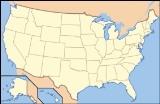
Little Bighorn Battlefield National Monument
Encyclopedia
Little Bighorn Battlefield National Monument preserves the site of the June 25, 1876, Battle of the Little Bighorn
, near Crow Agency, Montana
, in the United States
. It also serves as a memorial to those who fought in the battle: George Armstrong Custer
's 7th Cavalry
and a combined Lakota-Northern Cheyenne and Arapaho
force. Custer National Cemetery, on the battlefield, is part of the national monument
. The site of a related military action led by Marcus Reno
and Frederick Benteen
is also part of the national monument, but is about three miles (5 km) southeast of the Little Bighorn battlefield.
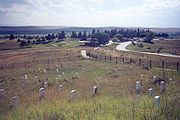

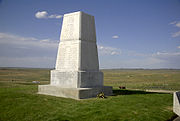
 The first memorial on the site was assembled by Captain George K. Sanderson
The first memorial on the site was assembled by Captain George K. Sanderson
and the 11th Infantry. They buried soldiers' bodies where they were found and removed animal bones. In his official report dated April 7, 1879, Sanderson wrote:
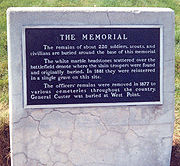 Lieutenant Charles F. Roe and the 2nd Cavalry built the granite memorial in July 1881 that stands today on the top of Last Stand Hill. They also reinterred soldiers' remains near the new memorial, but left stakes in the ground to mark where they had fallen. In 1890 these stakes were replaced with marble markers.
Lieutenant Charles F. Roe and the 2nd Cavalry built the granite memorial in July 1881 that stands today on the top of Last Stand Hill. They also reinterred soldiers' remains near the new memorial, but left stakes in the ground to mark where they had fallen. In 1890 these stakes were replaced with marble markers.
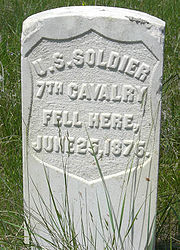 The bill that changed the name of the national monument also called for an "Indian Memorial" to be built near Last Stand Hill.
The bill that changed the name of the national monument also called for an "Indian Memorial" to be built near Last Stand Hill.
Markers honoring the Indians who fought at Little Big Horn, including Crazy Horse
, have been added to those of the U.S. troops. On Memorial Day
, 1999, the first of five red granite markers denoting where warriors fell during the battle were placed on the battlefield for Cheyenne warriors Lame White Man
and Noisy Walking.
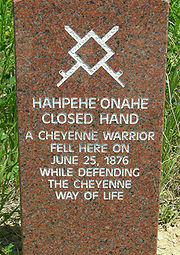 The warriors' red speckled granite memorial markers dot the ravines and hillsides just as do the white marble markers representing where soldiers fell. Since then, markers have been added for the Sans Arc
The warriors' red speckled granite memorial markers dot the ravines and hillsides just as do the white marble markers representing where soldiers fell. Since then, markers have been added for the Sans Arc
Lakota warrior Long Road and the Minniconjou Lakota Dog's Back Bone.
On June 25, 2003, an unknown Lakota warrior marker was placed on Wooden Leg Hill, east of Last Stand Hill to honor a warrior who was killed during the battle as witnessed by the Northern Cheyenne warrior Wooden Leg
.
Battle of the Little Bighorn
The Battle of the Little Bighorn, also known as Custer's Last Stand and, by the Indians involved, as the Battle of the Greasy Grass, was an armed engagement between combined forces of Lakota, Northern Cheyenne and Arapaho people against the 7th Cavalry Regiment of the United States Army...
, near Crow Agency, Montana
Crow Agency, Montana
Crow Agency is a census-designated place in Big Horn County, Montana, United States and is near the actual location for the Little Bighorn National Monument and re-enactment known as Custer's Last Stand...
, in the United States
United States
The United States of America is a federal constitutional republic comprising fifty states and a federal district...
. It also serves as a memorial to those who fought in the battle: George Armstrong Custer
George Armstrong Custer
George Armstrong Custer was a United States Army officer and cavalry commander in the American Civil War and the Indian Wars. Raised in Michigan and Ohio, Custer was admitted to West Point in 1858, where he graduated last in his class...
's 7th Cavalry
U.S. 7th Cavalry Regiment
The 7th Cavalry Regiment is a United States Army Cavalry Regiment, whose lineage traces back to the mid-19th century. Its official nickname is "Garryowen," in honor of the Irish air Garryowen that was adopted as its march tune....
and a combined Lakota-Northern Cheyenne and Arapaho
Arapaho
The Arapaho are a tribe of Native Americans historically living on the eastern plains of Colorado and Wyoming. They were close allies of the Cheyenne tribe and loosely aligned with the Sioux. Arapaho is an Algonquian language closely related to Gros Ventre, whose people are seen as an early...
force. Custer National Cemetery, on the battlefield, is part of the national monument
U.S. National Monument
A National Monument in the United States is a protected area that is similar to a National Park except that the President of the United States can quickly declare an area of the United States to be a National Monument without the approval of Congress. National monuments receive less funding and...
. The site of a related military action led by Marcus Reno
Marcus Reno
Marcus Albert Reno was a career military officer in the American Civil War and in the Black Hills War against the Lakota and Northern Cheyenne...
and Frederick Benteen
Frederick Benteen
Frederick William Benteen was a military officer during the American Civil War and then during the Black Hills War against the Lakota and Northern Cheyenne. He is notable for being in command of a battalion of the 7th U. S...
is also part of the national monument, but is about three miles (5 km) southeast of the Little Bighorn battlefield.
History of site

- 25 June 1876: Battle of Little Big Horn
- 29 January 1879: The Secretary of War first preserved the site as a U.S. National Cemetery, to protect graves of the 7th Cavalry troopers buried there.
- 1877: Custer, who had been buried there, was reinterred in West Point CemeteryWest Point CemeteryWest Point Cemetery is a historic cemetery on the grounds of the United States Military Academy in West Point, New York. It overlooks the Hudson River, and served as a burial ground for American Revolutionary War soldiers and early West Point inhabitants long before 1817 when it was officially...
. - 7 December 1886: The site was proclaimed National Cemetery of Custer's Battlefield Reservation to include burials of other campaigns and wars. The name has been shortened to "Custer National Cemetery".
- 5 November 1887: Battle of Crow Agency, three miles north of Custer battlefield
- 14 April 1926: Reno-Benteen Battlefield was added
- 1 July 1940: The site was transferred from the United States Department of WarUnited States Department of WarThe United States Department of War, also called the War Department , was the United States Cabinet department originally responsible for the operation and maintenance of the United States Army...
to the National Park ServiceNational Park ServiceThe National Park Service is the U.S. federal agency that manages all national parks, many national monuments, and other conservation and historical properties with various title designations... - 22 March 1946: The site was redesignated "Custer Battlefield National Monument".
- 15 October 1966: The site was listed on the National Register of Historic PlacesNational Register of Historic PlacesThe National Register of Historic Places is the United States government's official list of districts, sites, buildings, structures, and objects deemed worthy of preservation...
. - 11 August 1983: A wildfireWildfireA wildfire is any uncontrolled fire in combustible vegetation that occurs in the countryside or a wilderness area. Other names such as brush fire, bushfire, forest fire, desert fire, grass fire, hill fire, squirrel fire, vegetation fire, veldfire, and wilkjjofire may be used to describe the same...
destroyed dense thorn scrub which over the years had seeded itself about and covered the site. This allowed archaeologists access to the site. - 1984, 1985: Archaeological digging on site.
- 10 December 1991: The site was renamed Little Bighorn Battlefield National Monument by a law signed by President George H. W. BushGeorge H. W. BushGeorge Herbert Walker Bush is an American politician who served as the 41st President of the United States . He had previously served as the 43rd Vice President of the United States , a congressman, an ambassador, and Director of Central Intelligence.Bush was born in Milton, Massachusetts, to...
.
Memorials



George K. Sanderson
George Kaiser Sanderson was a career U.S. Army officer. Having enlisted as a Private he was latter commissioned and twice breveted for gallant and meritorious service during the American Civil War. He is most notable for being the first to erect a monument at the Little Bighorn Battlefield...
and the 11th Infantry. They buried soldiers' bodies where they were found and removed animal bones. In his official report dated April 7, 1879, Sanderson wrote:
"I accordingly built a mound out of cord wood filled in the center with all the horse bones I could find on the field. In the center of the mound I dug a grave and interred all the human bones that could be found, in all, parts of four or five different bodies. This grave was then built up with wood for four feet above ground. The mound is ten feet square and about eleven feet high; is built on the highest point immediately in rear of where Gen’l Custer’s body was found..."


Markers honoring the Indians who fought at Little Big Horn, including Crazy Horse
Crazy Horse
Crazy Horse was a Native American war leader of the Oglala Lakota. He took up arms against the U.S...
, have been added to those of the U.S. troops. On Memorial Day
Memorial Day
Memorial Day is a United States federal holiday observed on the last Monday of May. Formerly known as Decoration Day, it originated after the American Civil War to commemorate the fallen Union soldiers of the Civil War...
, 1999, the first of five red granite markers denoting where warriors fell during the battle were placed on the battlefield for Cheyenne warriors Lame White Man
Lame White Man
Lame White Man, or Ve'ho'enohnenehe, was a Cheyenne battle chief who fought at the Battle of the Little Big Horn, June 25, 1876 and was killed there. He was also known as Bearded Man and Mad Hearted Wolf...
and Noisy Walking.

Sans Arc
The Sans Arc, or Itázipčho in Lakota, are a subdivision of the Lakota people. Sans Arc is the French translation of the Lakota name which means, "Without bows." The translator of Wooden Leg: A Warrior Who Fought Custer renders the name as Arrows all Gone...
Lakota warrior Long Road and the Minniconjou Lakota Dog's Back Bone.
On June 25, 2003, an unknown Lakota warrior marker was placed on Wooden Leg Hill, east of Last Stand Hill to honor a warrior who was killed during the battle as witnessed by the Northern Cheyenne warrior Wooden Leg
Wooden Leg
Wooden Leg was a Northern Cheyenne warrior who fought against Custer at the Battle of the Little Big Horn.-Biography:...
.
External links
- Official NPS website: Little Bighorn Battlefield National Monument
- Friends of the Little Bighorn Battlefield
- Custer National Cemetery register
- History/cultural Tours.-Custer Battlefield Tours during reenactment.
- Grave of Curly
- Grave of White Man Runs HimWhite Man Runs HimWhite Man Runs Him - was a Crow scout serving with George Armstrong Custer’s 1876 expedition against the Sioux and Northern Cheyenne that culminated in the Battle of the Little Bighorn.-Early life:...
- How the Battle of Little Bighorn Was Won, from the Indians' point of view

